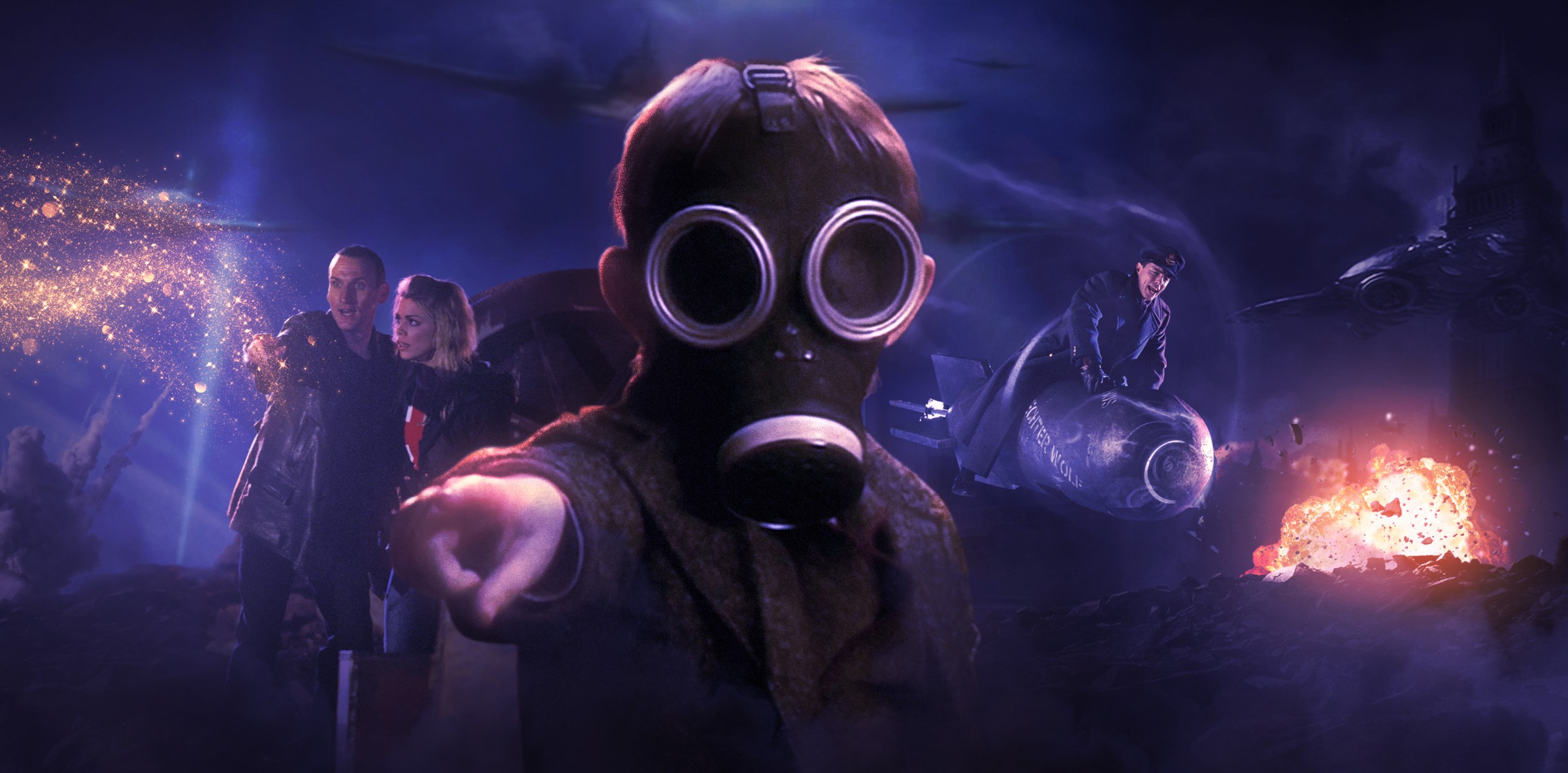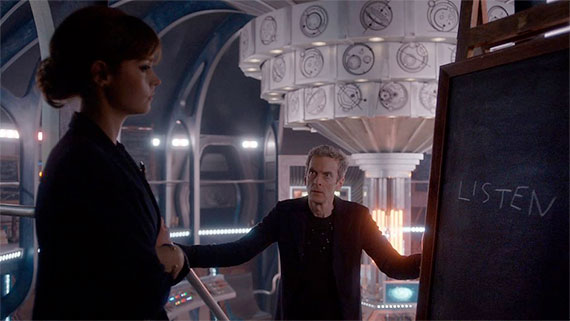Some of the strongest, most striking episodes of Doctor Who are those that have drunk deep of the horror well. Ostensibly a children’s show, Doctor Who has often taken great delight in terrifying the kiddies. In Britain, the term ‘behind the sofa’ is directly related to the show’s ability to send the watching kids scurrying for the safety of the rear of that comfortable piece of furniture, safe from the harrowing images on screen.
Horror, fear, terror. The very best of the scariest Doctor Who stories are listed below. Hit the comments section and tell Major Spoilers what are your scariest ever Doctor Who stories.
1 Horror of Fang Rock
One of the tropiest of Doctor Who tropes is the base under siege. Take a single location, trap your cast inside it, and then add a bizarre creature intent on picking them off one by one. This perfectly describes the lighthouse based story ‘Horror of Fang Rock’, written by perennial scriptwriter Terrance Dicks, and directed by one of the few women to get behind the camera in the classic era, Pennant Roberts. When the Doctor and Leela land on the ill-omened island of Fang Rock, another alien visitor lands in the nearby ocean. When a ship wrecks on the coast at the end of episode one, all the elements are in place for an escalating nightmare that almost overwhelms the Doctor’s cunning and intelligence.
The alien is a member of the shape shifting Rutan race, scouting options to invade the Earth. Like all great body horror, it first kills, then assumes the form of its victims. As the fog gathers and the tension ratchets up, along with the body count, the Doctor realizes in one of the most striking cliffhangers, that he has locked the monster inside the lighthouse with all of them.
There’s something fascinating and unnerving about 70s television horror in the United Kingdom. The grittiness of it and its lack of sentimentality elevate it above the slicker fare of later decades. While the series would move towards less horror and more humor after this season, there are a couple of stories in this season that have not only a high body count, but a high level of the odd, unnerving and downright spooky. A slow burn thrill ride from start to finish, ‘Horror of Fang Rock’ will grip you with all the tenacity and lethality of a Rutan tentacle.
2 The Image of the Fendahl
Another Tom Baker gem (and from the same season that featured ‘Horror of Fang Rock’) ‘Image of the Fendahl’ is obsessed with the many tropes of 1970s parapsychology. Not only does it borrow heavily from HP Lovecraft’s idea of alien gods beyond the understanding of the human mind, but the occult, ESP, witchcraft, possession, aliens and even the paleoanthropological discoveries of the Leakey’s also feature in a stunning mélange of high weirdness and downright creepiness.
Four scientists, Adam Colby, Max Stael, Thea Ransome and Doctor Fendelman are conducting experiments on a 12 million year old human skull they discovered in Kenya. Their experiments with the skull attempt to discover what the person looked like before they died. In doing so, they awaken the skull, which as the Doctor discovers, is the Fendahl, the very personification of death. So dangerous was it, that the Time Lords destroyed the creature’s home world, trapping it in a time loop. But it escaped and made its way to Earth.
Once again, a remote, creepy location (Fetch Priory), with an eerie monster, and the grisly deaths of an appealing cast of characters combine to terrify and unnerve over the course of four frightening episodes.
Writer Chris Boucher used all the tropes of that decade to craft a clever and spooky story. The direction by George Spenton-Foster is also exemplary. The budget stretched to some night shooting, which is used to stunning effect as the Fendahl stalks a hiker through the darkened woods. The rustling of the trees, and the hiker’s mounting unease and terror provide real chills as the Fendahl overwhelms and destroys him utterly. The atmosphere of the story, already thick with menace and dread, ramps up from here.
The addition of a local woman with the powers of witchcraft doesn’t detract, instead adding another layer of verisimilitude. This works well with the superstitious primitive, Leela, who is right at home amidst the horror. Leela’s understanding of the spirit world brings her more understanding of events than the scientific mumbo jumbo of the scientists and the Doctor, and it is that knowledge that is key to critical moments in the story.
Not only does it mine the obsessions of the 70s, but Image of the Fendahl also borrows heavily from the earlier works of noted British television screenwriter, Nigel Kneale, he of the Quatermass serials. Kneale’s work concentrates on the scientific reasons behind seemingly supernatural occurrences – race memory, genetic manipulation and possession all help account for what others would term the supernatural. But where Kneale uses his work to uncover the hypocrisy of humanity, stripping away its pretensions and revealing the manipulation of far older races, Boucher goes the other way.
As the Fendahl’s power grows it transforms a group of cultists into Fendahleen, monstrous worms that consume their victims whole. Thea Ransome becomes the Fendahl Queen, and anyone who catches her gaze is trapped, unable to move, in preparation to be devoured. When Max Stael falls victim to her, he begs the Doctor to hand him the gun from his pocket. In a scene never repeated in Doctor Who, the Doctor’s mercy results in an (off-screen, but heard) suicide. More a mercy killing, Stael’s death underscores the almost hopeless nature of dealing with the very personification of death.
3 The Empty Child
There’s a reason ‘The Empty Child’ won the Hugo from Best dramatic presentation, short form in 2006. Not only did it have the advantage of accomplished television writer Steven Moffat behind the typewriter, but it is a stonkingly scary and deeply unsettling piece of drama. Once again, Doctor Who combines the spooky and the historical to unnerving effect, this time during the London Blitz. When the Doctor and Rose arrive, they discover a city at peril not only from the air, but also a bizarre gas mask wearing child, bearing a catchphrase that would dominate the schoolyard for weeks afterwards.
The night time shooting, the fidelity to the era being depicted, the privation of the people under wartime conditions, and the heartfelt predicament of Nancy, the little boy’s single mother, all come together to create a powerful drama that the series needed at this point in its return. There were many who thought this first season would fail, that Doctor Who would be shown up for the shopworn and tired camp production many thought it had become in 1989. This confident script, with an increasingly confident production team, with a heavy weight lead actor in Christopher Eccelston, all demonstrated why Doctor Who was almost instantaneously the lead show in the BBC televisions schedule on its return.
But it is the scares that resonate more than anything else in The Empty Child. While I have a lot of problems with Moffat’s later work as showrunner, there is no denying the dazzling power of his first story for the new series, and the peerless set pieces littered throughout The Empty Child. When the phone starts ringing in the hutch on the TARDIS exterior, it is a moment that initially electrifies, as long term fans (of whom Moffat is one) will know this has never happened before in the series. When the Doctor answers and a little boy’s voice issues, asking ‘Are you my Mummy’ we know we are in the grip of something strange, frightening even.
Moffat’s trademark bait and switch is on full display in this story. The boy himself is not the creature of destruction, but instead it is the medical nanotechnology that has perverted his body and is killing those it comes in contact with. The ghastly way the people in the hospital ward are infected and transformed just demonstrates that what the audience really want, what they gather around the watercooler at work to discuss in hushed, thrilled tones, is a good scare. And when Doctor Constantine’s face transforms into a gas mask, you can almost hear the bones in his skull cracking (indeed, while the BBC stepped in a toned the sound effect down, I am still convinced to this day I heard those awful noises).
Doctor Who returned in 2005 with a massive bang. It lit up the television schedules and dominated popular culture in a way it hadn’t since the 1970s. Russell T Davies had a lot to do with giving the show its mass appeal, but it is Steven Moffat who richly deserves the accolades for terrifying the kids (and adults) with this chilling episode.
4 Listen
‘Fear makes companions of us all’
Of all the new series Doctors, it is Peter Capaldi’s darker, somber, angrier portrayal that captures my withered heart. Older than the other actors to play the role since 2005, with a face that can only be described as careworn, his portrayal more than any other was worthy of stories that ventured into the scary, scary dark.
And what a story ‘Listen’ is. If nothing else, Steven Moffat can take the simplest idea, say, that of the fear everyone has of a hand reaching from under the bed and grabbing your ankle, and turn the dread factor up to 11. After Clara has an argument with her beau, Danny, she and the Doctor venture back in time, ostensibly to her childhood, but instead to Danny’s. There, in a home for children, they find a young Danny and something under the blanket on his bed. The whole set up of this sequence is superb. Lonely corridors, the Doctor appearing and disappearing, the apparition in Danny’s bedroom, the shape under the bed, and the out of focus figure in the background. It is such a simple set up that it only helps make the scenes that much more unnerving, in a way that much of the new series, with all its visual pyrotechnics often isn’t.
But it keeps on getting better. Obsessed with hunting down this entity, the Doctor finds himself, with an astronaut descendent of Danny, stranded at the end of the universe. Trapped inside a ship, on a desolate rock as the darkness encroaches, the Doctor hears a knocking at the door. Like the Third Doctor, who allowed temptation for knowledge to lead to his downfall, the Doctor hungers to know what it is that stands on the other side of the airlock door.
As much a story about the Doctor’s fascination with just about anything in the universe, ‘Listen’ is also about the fears that animate individuals. For Danny, the fear of what was under the bed motivated him to become a soldier, with the help of the Doctor’s intervention. For the Doctor, his interest in the creature he thinks he sees is as much about his boundless curiosity as it is about something lurking under his bed. The eventual denouement, where it is revealed that the hand under the bed in the barn on Gallifrey is none other than Clara’s, is both a strangely satisfying moment, and yet, a strangely unsettling one as well. Because, if your best friend is the cause of your greatest childhood fear, imagine what nightmares you actual enemies could instil in you…
5 Hide
Novelist and screenwriter Neil Cross’s first contribution to Doctor Who is the ghost story flavoured, Quatermass (that name again – Nigel Kneale’s creation is like a thick strand of DNA right through the history of the show) inspired spookfest that is only let down by the ‘love conquers all’ ending that feels tacked on. Up until that point, ‘Hide’ is a creepily effective episode set in the 1970s, using some of the very same tropes appearing in ‘Image of the Fendahl.’
Former World War II special operative turned Professor, Alec Palmer, and his younger assistant, Emma Grayling, are on the hunt for ghosts in Caliburn House. When the Eleventh Doctor and his new companion, Clara, arrive, they are immediately enmeshed in the investigation, and the strange Crooked Man is said to haunt the place. Emma’s strong psychic powers are used by Palmer in his attempts to summon the Crooked Man and study the phenomenon, which causes all manner of strange events inside the house.
Neil Cross is best known for ‘Luther’ cop drama series, starring Idris Elba. He’s less known, but should be better known, for a number of really (and I mean really) gritty crime infused novels. If you like your plotting unsentimental, and your characters prone to all manner of misfortune, with an excellent sense of plotting and pacing, I would recommend you try some of them, particularly ‘Captured.’ While ‘Hide’ has very little of the grittiness of his novels, it does have an excellent sense of mood and atmosphere, a hallmark of his writing in general.
So what makes ‘Hide’ worthy of being in the Top 5? The setting for one, which is a stately manner in the wilds of Britain, haunted by shadows, history and the possibility of a menacingly named ghost. Jamie Payne’s direction is first rate, making excellent use of the location shooting at a National Trust building. Another are the clear links to another classic example of television horror, ‘The Stone Tape’ again set in the 1970s, with a strong female (and doomed) protagonist. Again, ‘The Stone Tape’ is written by Nigel Kneale, and Cross clearly borrows the concepts of this brilliant piece of television drama – the scientists researching a ghostly apparition and noises using science, is a clear reference to what Palmer and Emma are attempting to summon and understand. And with Clara as the new companion, and clear link with the audience, we see in her fearful reactions to what is going on around her echoed in our own nervousness at events on the screen.
As I said earlier, the ending to ‘Hide’ is something of a letdown, but even then it doesn’t derail the delicious sense of dread and atmosphere that Cross creates, and director Jamie Payne delivers in the visuals, up until that point. While there is a lot of horror about in the modern golden age of television, there’s nothing as deliciously strange, and insidious and on occasion, positively frightful, as the blend of science fiction and horror that Doctor Who is so often capable of delivering. Turn the lights down, cuddle up to your significant other, and don’t worry about the figure staring at you from the shadows in the corner. Or maybe you should…
Dear Spoilerite,
At Major Spoilers, we strive to create original content that you find interesting and entertaining. Producing, writing, recording, editing, and researching requires significant resources. We pay writers, podcast hosts, and other staff members who work tirelessly to provide you with insights into the comic book, gaming, and pop culture industries. Help us keep MajorSpoilers.com strong. Become a Patron (and our superhero) today.








2 Comments
Good list. I think Don’t Blink would good contender.
Blink was definitely in the conversation in my head.
There’s a half dozen from the first 3 years of Tom Baker’s run that are strong contenders, as well. There are stories prior to it that have spooky moments, but the production team in those three years actively strip mined any number of horror tropes/movies for their stories.
Thanks for the kind comment!